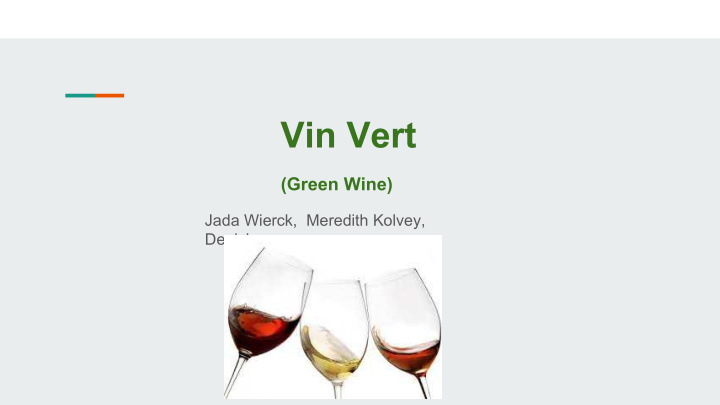



Vin Vert (Green Wine) Jada Wierck, Meredith Kolvey, Denisha
The History of Wine ● Wine used to be drank back in the day due to it being a safe beverage, and it was mixed with water to make the water safer ● Wine was cheaper than water
Production ● Wine is produced from the planting of the grape seeds, which are then maintained for months, picked, cleaned, transformed, transported, and finally distributed ● 4.6 billion liters of wine produced per year ● Wine is best grown at the top of the hill to encourage longer root and higher yields. ● Masteration process
Sparkling Wine
Choosing the right grape ● Sugar content ● Acidity ● Tannins ● Antioxidants ● Champagne ● Chardonnay ● Red wine ● White wine
Transport to the winery ● The transportation from the vineyard to the winery is where most of CO2 production from the wine making process occurs ● Truck size is determined by harvest rate : ○ Low = 50 kilo/hr. ○ Medium = 100 kilo/hr. ○ High = 200 kilo/hr. ● Due to the sensitivity of grapes, there are general guidelines that have to be followed; these include the maintenance of temperature, humidity, ventilation of the trailer.
Aging and Storage ● Barrels are most commonly used to age and store wine. ● Barrels lose their flavor the longer they are used, so they are replaced often (2-4 yrs) ● Aging in stainless steel is an a more sustainable option, but less desirable by the wine producer than the traditional barrel. ● Older barrels sold to smaller wineries or distilleries ● Aging wine in barrels uses less sulfer in wines and preserves it
Wine Packaging ● Corks imported from Portugal (cheaper) ● 9 years for trees to recover (from cork process) ● Date of bottle pertains to harvest ● Label added after knowing what country it is going to depending on warnings
Which package is better? Glass is recyclable, but difficult to do so. It’s also heavy and shatters easily. Plastic bottles are lightweight, shatter resistant, and easily recyclable. Bag in box are lightweight, shatter proof, the bag is not recyclable, but the box is and its collapsible meaning more can be transported at once.
Distribution ● France is the number one country in the exportation of wine ● In 2015, France produced 5.6 billion liters of wine ○ 4.6 billion remained in the country and 1.4 billion exported ● Most of the wine consumed world wide is imported from France ● According to an article, “In the Wine Annual Report and Statistics”, it states the main wine providers are direct suppliers at 75%, cash and carry 50%, and wholesalers (large company that sells goods in large quantities at low prices) at 47%
Regulating Wine ● The average consumers of wine around the world are aged 50 to 60. ● Among other regulations, ads to that glamorize and display alcohol as pleasurable are not allowed. ● In 2010 the U.S. surpassed France in wine consumption.
Pollution ● Pollution prevention refers to the systemic use of products and industrial processes designed from their inception to prevent the pollution of air, water, land, reduce waste, and to minimize risks to the environment and humans. ● According to an article, “ “ the owner of the vineyard adopted many practices to reduce pollution and increase his biodiversity in his fields ● He does this through planting grasses and hedges for insects to nest and feed in grape pest. Also, he spreads the pheromones of female butterflies around his vines to induce what he calls “sexual confusion” which causes the caterpillars to become too frenzies by the scent to burrow into grapes and lay eggs in them ● Results: he saw a 90% drop of use of pesticides, and the whole region saw a 50% drop
Organic Vineyards/ Bio-Vineyards ● Vazarts practices are an example of organic growing technique ● Gaining Popularity in France: Grown in number five fold from 1995 - 2013 ● Persistent fungal diseases make this method difficult ● Preferred by customers in France
Sancerre Winery Sustainability Stats ● Mechanical removal of weeds ● Use of fungicides ● Skins and pulp taken and utilized by a governmental program ● Nuclear energy used to power production ● Wine bottled in glass in site.
Sustainability Programs SUSTAVINO (Europe) ● Europe created a project called ‘Integrated approaches for sustainable European wine production’ ● This project came up with an environmental quality strategy for sustainable wine productions and encompassed cost- effective and ecologically responsible treatments ● They also performed testings on winery waste and water quality across Europe California Sustainable Wine Growing Alliance(U.S.) ● Self-assessment ● Focus is on water and energy efficiency, pest and waste management, soil health, wildlife habitat, neighbors and community, and employees
Recommend
More recommend